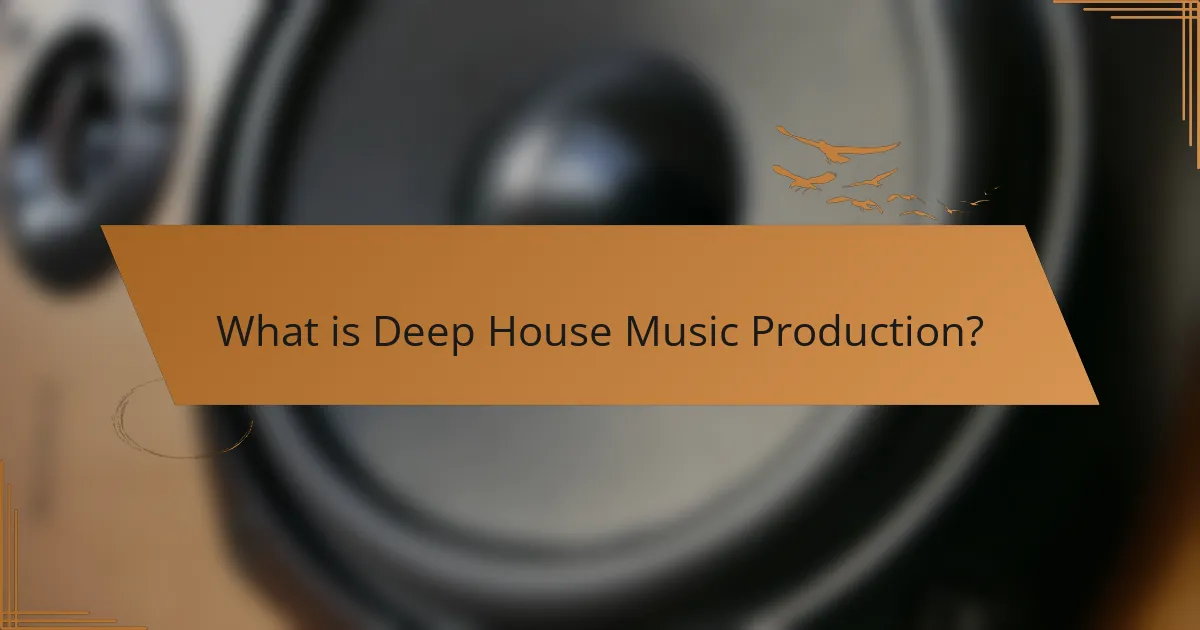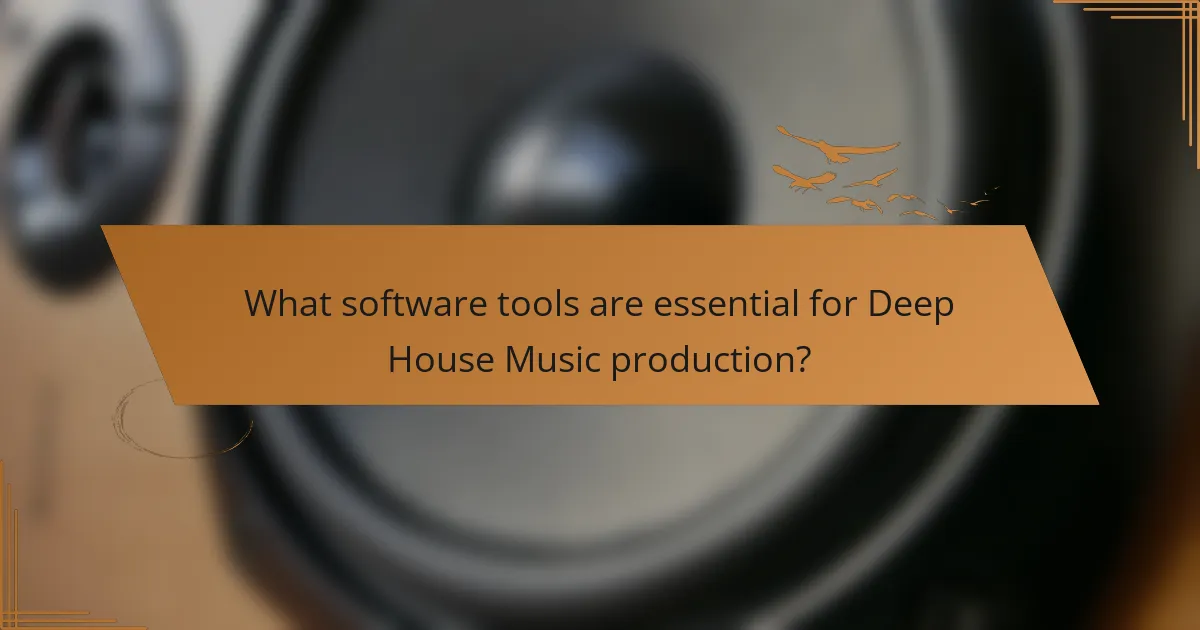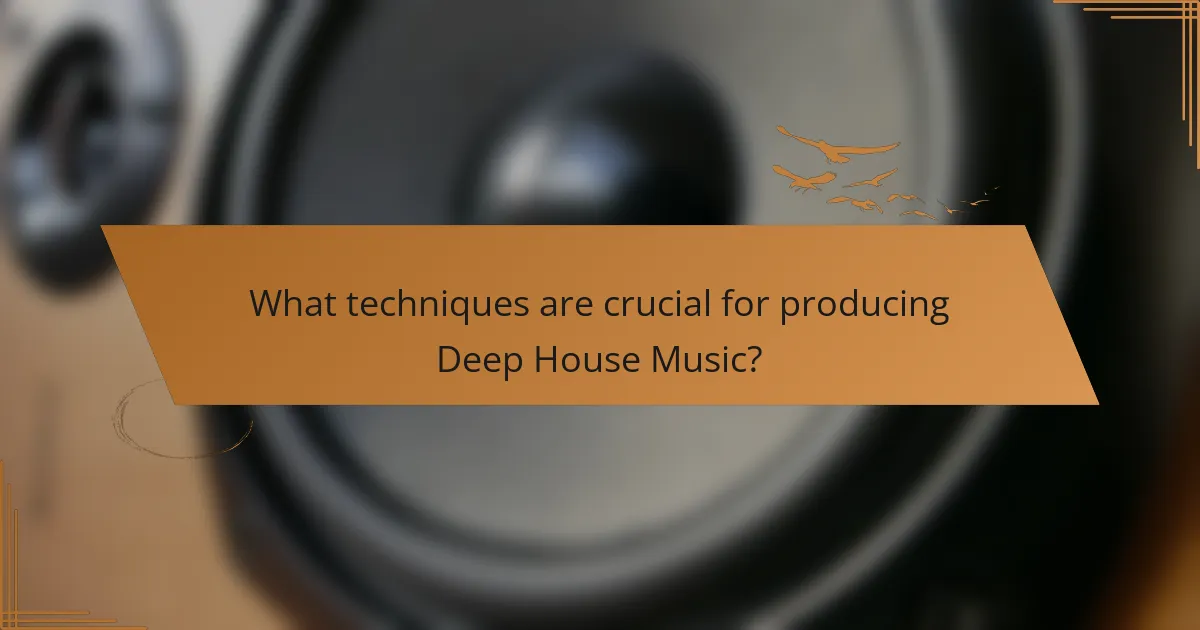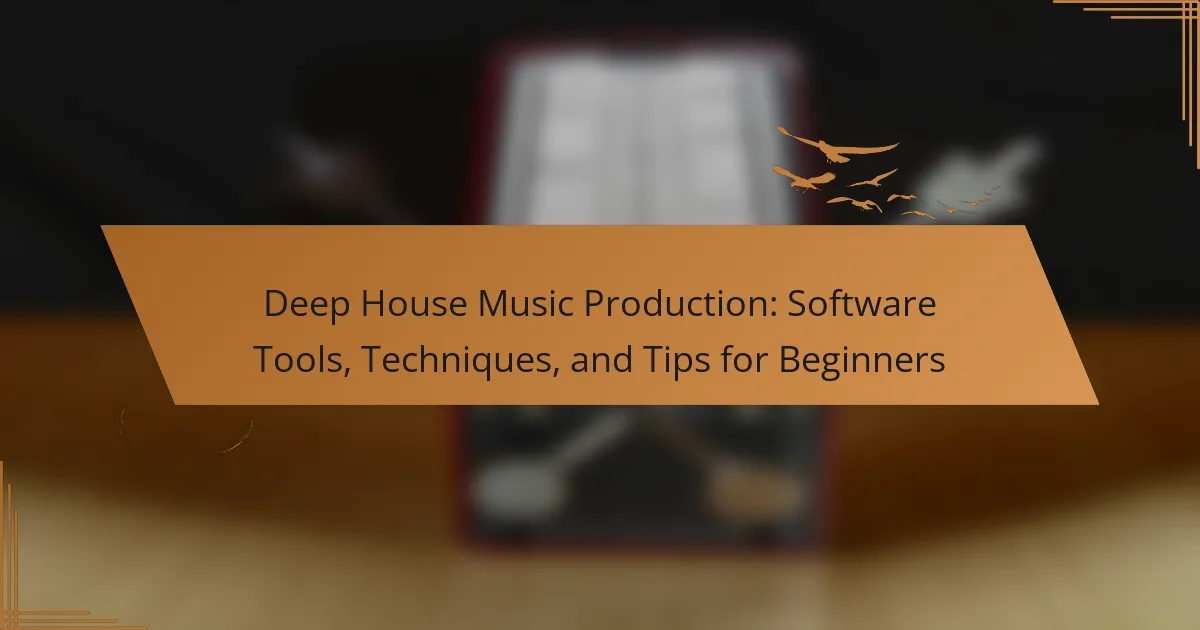Deep House Music Production involves the creation of deep house music, a subgenre known for its complex melodies, soulful vocals, and atmospheric elements. This process utilizes digital audio workstations (DAWs) like Ableton Live, FL Studio, and Logic Pro X, alongside synthesizers and effects plugins to compose, arrange, and mix tracks. Key production techniques include crafting solid basslines, incorporating smooth chords, and layering sounds to enhance texture and depth. Essential rhythmic elements such as shuffling hi-hats and syncopated percussion contribute to the genre’s distinctive groove, while effective mixing and mastering ensure a polished final product. This article provides an overview of the necessary software tools, techniques, and tips for beginners in deep house music production.

What is Deep House Music Production?
Deep House Music Production is the process of creating deep house music, a subgenre of house music characterized by its complex melodies and soulful vocals. This production involves using digital audio workstations (DAWs) and various software tools to compose, arrange, and mix tracks. Techniques such as sampling, layering, and sound design are commonly employed to achieve the genre’s signature sound. Deep house music often features a slower tempo, typically between 120 and 125 beats per minute. The genre is known for its emphasis on atmospheric elements and deep basslines. Producers often draw inspiration from jazz, funk, and soul music. The use of synthesizers and drum machines is prevalent in deep house music production. This genre has gained popularity in clubs and festivals worldwide, reflecting its widespread appeal.
How did Deep House Music originate?
Deep House Music originated in the 1980s as a subgenre of house music. It emerged from Chicago’s vibrant club scene, influenced by disco and jazz elements. Pioneers like Larry Heard played a crucial role in its development. Deep house is characterized by its smooth, soulful sound and complex melodies. The genre gained popularity in the late 1980s and early 1990s, particularly in Europe. Key characteristics include the use of deep basslines and atmospheric synths. By the mid-1990s, deep house became a staple in clubs worldwide. Its evolution continues to influence contemporary electronic music today.
What are the defining characteristics of Deep House Music?
Deep House Music is characterized by its soulful melodies, smooth basslines, and atmospheric soundscapes. It typically features a tempo range of 120 to 125 BPM. The genre often incorporates elements of jazz, funk, and soul, creating a rich auditory experience. Vocals in deep house are usually soft and emotive, enhancing the overall vibe. The use of lush chords and synth pads adds depth to the tracks. Percussion is often subtle, focusing on hi-hats and snares to maintain a laid-back feel. The genre emerged in the 1980s, influenced by Chicago house and Detroit techno. Its defining traits make it distinct within the broader electronic music landscape.
How has Deep House Music evolved over the years?
Deep House Music has evolved significantly since its inception in the 1980s. Initially, it emerged from Chicago house music, characterized by its slower tempo and jazzy influences. In the 1990s, Deep House gained popularity in Europe, particularly in the UK and Germany. This era saw the incorporation of soulful vocals and lush melodies.
The 2000s introduced a more minimalistic approach, focusing on atmospheric sounds and deeper basslines. Artists like Kerri Chandler and Larry Heard played pivotal roles in shaping the genre. By the late 2010s, Deep House had integrated elements from various electronic music styles, including tech house and ambient music.
Today, it features a blend of traditional and modern production techniques, often utilizing software tools like Ableton Live and FL Studio. The genre continues to thrive in clubs and festivals worldwide, showcasing its adaptability and enduring appeal.
What are the key elements of Deep House Music production?
The key elements of Deep House Music production include rhythm, basslines, chords, and vocal elements. Rhythm typically features a four-on-the-floor beat, creating a steady groove. Basslines in deep house are often smooth and melodic, providing depth. Chord progressions are usually rich and harmonic, enhancing emotional expression. Vocal elements can be soulful or atmospheric, adding character to tracks. Additionally, the use of atmospheric sounds, such as pads and synths, contributes to the genre’s signature vibe. These elements combine to create the distinctive sound of deep house music.
What role do beats and rhythms play in Deep House Music?
Beats and rhythms are fundamental elements in Deep House Music. They create the foundation that drives the genre’s groove and energy. The typical beat in Deep House features a four-on-the-floor kick drum pattern. This pattern maintains a steady tempo, often ranging from 120 to 125 BPM. Rhythmic elements, such as hi-hats and snares, add texture and complexity. Syncopation is frequently used to create interest and movement within the track. The interplay between beats and rhythms establishes a hypnotic feel, characteristic of Deep House. This rhythmic structure encourages dancing and enhances listener engagement. Ultimately, beats and rhythms shape the overall atmosphere and emotional impact of Deep House Music.
How do melodies and harmonies contribute to the genre?
Melodies and harmonies are essential components of deep house music. They create emotional depth and atmosphere, which are crucial for the genre. Melodies often feature smooth, flowing lines that evoke feelings of relaxation and introspection. Harmonies typically use rich, extended chords that enhance the overall sound texture.
In deep house, the interplay between melodies and harmonies establishes a groove that invites listeners to engage. The use of syncopation in melodies adds rhythmic interest, while harmonies provide a lush backdrop. This combination contributes to the genre’s signature sound, characterized by a blend of soulful and electronic elements.
Moreover, the harmonic progressions in deep house often draw from jazz and soul influences, creating a unique sonic identity. The layering of melodic and harmonic elements helps to build tension and release, essential for maintaining listener interest. Overall, melodies and harmonies are fundamental in defining the immersive experience that deep house music offers.

What software tools are essential for Deep House Music production?
Essential software tools for Deep House Music production include Digital Audio Workstations (DAWs), synthesizers, and effects plugins. Popular DAWs for this genre are Ableton Live, FL Studio, and Logic Pro X. These platforms provide comprehensive tools for composing, arranging, and mixing tracks.
Synthesizers like Serum, Massive, and Sylenth1 are crucial for creating rich, deep basslines and atmospheric pads. Effects plugins such as reverb, delay, and EQ enhance the sound quality and depth of tracks.
Using these tools, producers can effectively craft the signature sound of Deep House music. The combination of DAWs, synthesizers, and effects is widely recognized in the electronic music community for its effectiveness.
Which Digital Audio Workstations (DAWs) are best for beginners?
The best Digital Audio Workstations (DAWs) for beginners include GarageBand, FL Studio, and Ableton Live Lite. GarageBand is user-friendly and free for Mac users. It offers a wide range of instruments and loops, making it ideal for novice producers. FL Studio is known for its intuitive interface and pattern-based workflow. It provides a demo version that allows users to explore its features. Ableton Live Lite, often bundled with hardware, offers a simplified version of the full software. It is great for live performance and studio production. These DAWs are recommended due to their accessibility and supportive communities.
What features should beginners look for in a DAW?
Beginners should look for user-friendly interfaces in a DAW. A simple layout helps in navigating the software easily. Additionally, essential features include multi-track recording capabilities. This allows users to layer sounds effectively. Beginners also benefit from built-in virtual instruments. These instruments provide a range of sounds to experiment with. MIDI support is crucial for creating music with external devices. Furthermore, a good DAW should offer a variety of audio effects. These effects enhance sound quality and creativity. Lastly, compatibility with different operating systems is important. This ensures that users can install the DAW on their preferred devices.
How do different DAWs compare for Deep House Music production?
Different DAWs offer unique features for Deep House music production. Ableton Live is favored for its session view and flexibility in live performance. FL Studio provides an intuitive interface and powerful step sequencer, ideal for beat-making. Logic Pro X includes a vast library of samples and plugins, enhancing sound design capabilities. Cubase is known for its MIDI capabilities, making it suitable for complex compositions. Each DAW has strengths that cater to various aspects of Deep House production, such as workflow, sound design, and performance needs.
What plugins and virtual instruments are useful for Deep House?
Useful plugins and virtual instruments for Deep House include Serum, Massive, and Omnisphere. Serum is known for its high-quality wavetable synthesis. Massive offers a wide range of bass and lead sounds. Omnisphere is celebrated for its extensive sound library and versatility. Other notable plugins are Sylenth1 and Spire, both popular for their rich sounds. Additionally, plugins like Valhalla Room and FabFilter Pro-Q are excellent for reverb and EQ. These tools help create the lush textures characteristic of Deep House music.
What types of synthesizers are commonly used in Deep House?
Commonly used synthesizers in Deep House include analog, digital, and software synthesizers. Analog synthesizers like the Roland Juno-106 provide warm, rich sounds. Digital synthesizers such as the Yamaha DX7 offer unique FM synthesis capabilities. Software synthesizers, including Serum and Massive, are popular for their versatility and extensive sound design options. These synthesizers contribute to the characteristic deep basslines and lush pads found in Deep House tracks. Their ability to create complex textures is essential for this genre.
How can effects plugins enhance Deep House tracks?
Effects plugins can enhance Deep House tracks by adding depth, texture, and atmosphere. These plugins manipulate sound to create unique auditory experiences. Reverb can create spaciousness, making tracks feel larger and more immersive. Delay can add rhythmic interest and complexity to melodies and vocals. EQ helps in shaping the frequency spectrum, allowing elements to sit better in the mix. Compression controls dynamics, ensuring a polished and cohesive sound. Distortion can introduce warmth and character, enriching the overall tone. Modulation effects like chorus and flanger can create movement and variation, keeping the listener engaged. Together, these plugins contribute to a professional and polished final product.

What techniques are crucial for producing Deep House Music?
Key techniques for producing Deep House Music include using a solid bassline, incorporating smooth chords, and creating atmospheric pads. A prominent bassline typically operates in a sub-bass range, providing a deep foundation. Smooth chords often utilize extended harmonies to create richness and depth. Atmospheric pads enhance the overall texture and mood of the track.
In addition, rhythmic elements such as shuffling hi-hats and syncopated percussion patterns are essential. These elements contribute to the groove characteristic of Deep House. Utilizing effects like reverb and delay can also add spatial depth to the mix.
Layering sounds effectively is crucial for achieving a polished production. This involves combining multiple sounds to create a fuller, more immersive experience. Finally, attention to mixing and mastering ensures that all elements are balanced and cohesive, which is vital for professional-sounding tracks.
How do you create a Deep House track from scratch?
To create a Deep House track from scratch, start with selecting a Digital Audio Workstation (DAW). Popular DAWs include Ableton Live and FL Studio. Next, set the tempo between 120 to 125 BPM, which is typical for Deep House. Create a drum pattern using kick, snare, and hi-hat sounds to establish the rhythm. Incorporate basslines that are deep and groovy, often using synths or sampled bass sounds. Add chords and pads to create atmosphere and depth in the track. Use vocal samples or melodies to enhance the emotional impact. Finally, mix the track by balancing levels, adding effects, and ensuring clarity. This process follows industry practices for producing Deep House music effectively.
What is the process for arranging a Deep House track?
Arranging a Deep House track involves several key steps. First, start with a solid foundation by creating a drum pattern. This typically includes a kick drum on every beat and hi-hats to add rhythm. Next, introduce basslines that complement the kick. Deep House often features warm, deep bass sounds.
After establishing the rhythm section, layer in chords and pads. These elements provide harmonic support and atmosphere. Incorporate melodic elements, like synth leads or vocal samples, to add interest.
Transitions are crucial in Deep House. Use techniques like filtering or adding effects to create smooth changes between sections. Finally, structure the track with an intro, build-up, drop, breakdown, and outro.
Each section should flow naturally into the next. The arrangement should maintain listener engagement throughout. This process aligns with common practices in Deep House music production.
How do you mix and master Deep House music effectively?
To mix and master Deep House music effectively, start by balancing the levels of each track. Use EQ to carve out space for each element in the mix. Focus on the kick and bass relationship, ensuring they complement each other. Apply compression to control dynamics and maintain a consistent sound. Use reverb and delay to create depth and space in the mix. Pay attention to stereo imaging, placing elements appropriately in the left and right channels. For mastering, aim for a loudness level around -14 LUFS for streaming platforms. Finally, use a limiter to prevent clipping while maximizing volume.
What tips can help beginners improve their Deep House production skills?
To improve Deep House production skills, beginners should focus on mastering their Digital Audio Workstation (DAW). Choosing a user-friendly DAW like Ableton Live or FL Studio can enhance workflow. Learning basic music theory helps in creating harmonious melodies and chord progressions. Experimenting with sound design through synthesizers can develop a unique sound. Utilizing samples and loops effectively can add depth to tracks. Practicing mixing techniques is crucial for achieving a polished sound. Analyzing professional Deep House tracks provides insights into arrangement and structure. Lastly, seeking feedback from peers can help identify areas for improvement.
How can listening to other Deep House tracks enhance your production?
Listening to other Deep House tracks can significantly enhance your production skills. It exposes you to diverse sound design techniques. You can analyze how professionals structure their tracks. This includes understanding arrangement, layering, and mixing practices. Listening helps identify effective use of rhythm and melody. You can also discover unique sound choices and effects. By studying these elements, you can improve your own creative process. Research indicates that active listening enhances musical skills and creativity. This can lead to more innovative productions in your work.
What common mistakes should beginners avoid in Deep House production?
Beginners in Deep House production should avoid several common mistakes. One mistake is neglecting sound selection. Using low-quality samples can lead to a muddy mix. Another mistake is over-processing tracks. Excessive effects can clutter the sound and diminish clarity. Additionally, beginners often overlook arrangement. A lack of structure can make tracks feel disjointed.
Not paying attention to mixing levels is also a frequent error. Unbalanced levels can result in a track that sounds weak or harsh. Beginners may also fail to utilize automation. This can limit the dynamic range of their productions. Finally, skipping the mastering process can leave tracks sounding unpolished. Each of these mistakes can hinder the overall quality of Deep House music.
Deep House Music Production encompasses the creation of deep house music, characterized by complex melodies, soulful vocals, and a slower tempo of 120 to 125 BPM. The article covers the origins of deep house, its defining characteristics, and the evolution of the genre over the years. Key elements of production, including rhythm, basslines, chords, and vocal elements, are highlighted along with essential software tools and techniques for beginners. Additionally, the article provides practical tips for mixing, mastering, and avoiding common mistakes in deep house production, making it a comprehensive guide for aspiring producers.
